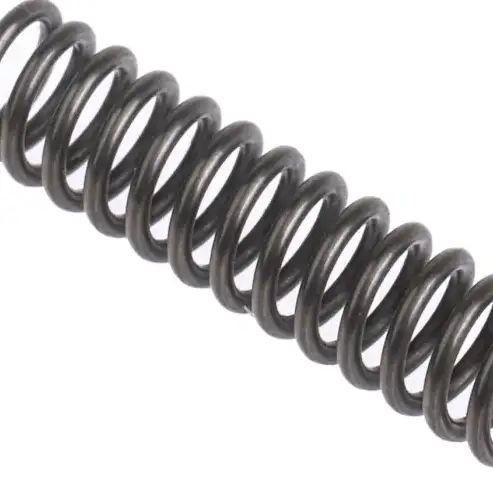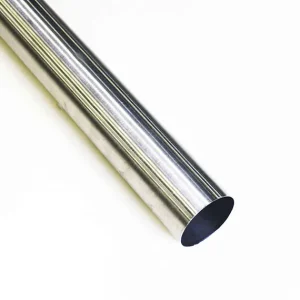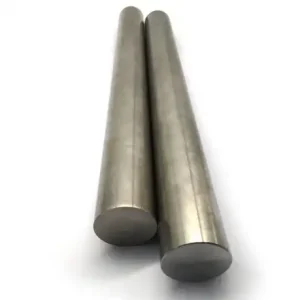Alloy 20 springs deliver outstanding performance in aggressive environments, combining superior corrosion resistance, robust mechanical strength, and excellent fabrication properties. MWAlloys’ Chinese-manufactured Alloy 20 springs offer a 100% factory-price advantage, rapid delivery of stock items, and full customization to meet precise specifications.
1. What is Alloy 20 Springs
Alloy 20 (UNS N08020) is a nickel–iron–chromium alloy enhanced with molybdenum, copper, and low carbon content. Springs fabricated from this alloy excel where chloride-induced corrosion and reducing acids threaten lesser materials. MWAlloys leverages state-of-the-art forging and CNC coiling processes to produce springs that satisfy critical applications in chemical processing, pharmaceutical equipment, food handling, and pollution control.
2. Chemical Composition
Alloy 20’s tailored chemistry delivers its hallmark resistance and strength. The following table presents typical weight-percent ranges:
| Element | Min | Max |
|---|---|---|
| Nickel (Ni) | 32.0 | 38.0 |
| Chromium (Cr) | 19.0 | 21.0 |
| Molybdenum | 2.0 | 3.0 |
| Copper (Cu) | 3.0 | 4.0 |
| Iron (Fe) | Balance | — |
| Carbon (C) | — | 0.07 |
| Manganese | — | 2.0 |
| Silicon | — | 1.0 |
| Sulfur (S) | — | 0.03 |
3. Metallurgical Characteristics
- Austenitic Structure: Fully austenitic at room temperature, guaranteeing ductility and toughness.
- Low Carbon: Minimizes carbide precipitation during welding, preventing intergranular corrosion.
- Solid Solution Strengthening: Nickel and chromium create a stable matrix resisting deformation.
4. Mechanical Properties
Alloy 20 springs must meet stringent strength and elasticity criteria. Typical annealed and cold-worked properties follow:
| Condition | Tensile Strength (MPa) | Yield Strength (0.2% offset, MPa) | Elongation (%) | Hardness (HRB) |
|---|---|---|---|---|
| Annealed | 515–690 | ≥205 | ≥40 | 70–85 |
| Cold-worked (20% CW) | 760–940 | ≥490 | ≥25 | 85–95 |
| Cold-worked (40% CW) | 860–1030 | ≥620 | ≥15 | 95–100 |
5. Corrosion Resistance Characteristics
Alloy 20 springs withstand chloride pits, sulfuric acid, phosphoric acid, and sea water environments. Key resistance features include:
- Uniform Attack Resistance against diluted inorganic acids up to intermediate concentrations.
- Pitting and Crevice Resistance, attributed to balanced molybdenum and copper levels.
- Stress Corrosion Resistance superior to standard austenitic stainless steels in chloride-laden atmospheres.
6. What is Alloy 20 used for?
Typical deployment areas for Alloy 20 springs encompass:
Chemical and Petrochemical Processing
-
Tanks, piping, heat exchangers, and pumps.
-
Ideal for handling sulfuric acid, nitric acid, phosphoric acid, and chloride-containing solutions.
-
Used in scrubbers, reactor vessels, and distillation columns.
Pharmaceutical Industry
-
Equipment exposed to cleaning agents and process chemicals.
-
Batch reactors, centrifuges, and dosing pumps.
-
Alloy 20 ensures metal ion leach resistance, critical for drug purity.
Food and Beverage Industry
-
Utilized in processing equipment, especially for acidic foods like citrus juice and vinegar.
-
Prevents contamination from corrosive food byproducts such as lactic or citric acids.
Power Generation and Desalination
-
Condensers, cooling systems, and brine heaters.
-
Performs well in chloride-rich environments (seawater, brine).
Pulp and Paper Industry
-
Bleaching systems, which often contain chlorine dioxide or sulfuric acid.
-
Alloy 20 is resistant to oxidizing and reducing media.
Waste Treatment and Pollution Control
-
Found in flue gas scrubbers, incineration systems, and acid recovery units.
-
Suitable for handling acidic slurries and corrosive waste fluids.
Oil & Gas Industry
-
Downhole equipment and sour gas service.
-
Resists hydrogen sulfide (H₂S) and CO₂-induced corrosion.
Pickling Equipment
-
In steel processing plants, where equipment is exposed to hydrochloric, nitric, or sulfuric acid baths.
-
Alloy 20 offers superior longevity over stainless steels.
7. Manufacturing Process
- Procurement of Melted Ingots following ASTM B473 standards.
- Hot Forging to eliminate macrosegregation and refine grain structure.
- Precision Coiling using CNC spring machines to achieve tight tolerances.
- Stress Relief Annealing at 620–680 °C to stabilize plastic deformation.
- Shot Peening optional for fatigue life enhancement.
- Final Inspection with dimensional checks and hardness verification.
8. Quality Standards and Certifications
- ASTM B473/B473M – Nitronic® Series Bars
- ASTM A276/A276M – Bars, Rods, and Wire for Stainless Steel Springs
- ISO 9001:2015 – Quality Management System
- RoHS Compliant – Restriction of Hazardous Substances
- NACE MR0175/ISO 15156 – Sour-service materials
Official certifications ensure MWAlloys’ spring production aligns with global expectations for safety and reliability.
9. Dimensional Standards: Sizes and Weight Comparison
Alloy 20 spring dimensions vary by wire diameter, coil diameter, and free length. The table below compares typical spring sizes with corresponding weight:
| Wire Diameter (mm) | Outer Diameter (mm) | Free Length (mm) | Weight per 100 springs (kg) |
|---|---|---|---|
| 1.0 | 10 | 20 | 0.05 |
| 1.5 | 15 | 30 | 0.18 |
| 2.0 | 20 | 40 | 0.40 |
| 3.0 | 30 | 60 | 1.20 |
| 5.0 | 50 | 100 | 5.00 |
10. Global Price Comparison
Pricing fluctuates based on regional costs, alloy demand, and logistics. Below is an indicative comparison per kilogram of finished spring:
| Region | Price (USD/kg) |
|---|---|
| China (MWAlloys) | 15–18 |
| United States | 25–30 |
| Europe | 23–28 |
| Japan | 27–32 |
| India | 17–20 |
MWAlloys leverages integrated foundry and fabrication to reduce cost by up to 40% relative to Western producers.
11. Comparison with Alternative Alloys
| Property | Alloy 20 | 316L Stainless | Hastelloy C276 |
|---|---|---|---|
| Corrosion in Sulfuric Acid | Excellent | Fair | Excellent |
| Pitting Resistance | High | Moderate | Very High |
| Cost per kg | Moderate | Lower | High |
| Fabrication Ease | Good | Excellent | Challenging |
| Stress Corrosion Resistance | Superior | Fair | Superior |
Alloy 20 often strikes the best balance of cost, performance, and fabrication.
12. What is Alloy 20 equivalent to?
Alloy 20 Equivalents in Other Standards
| Standard/System | Equivalent Grade | Notes |
|---|---|---|
| UNS (Unified Numbering System) | N08020 | Primary designation |
| ASTM | ASTM B473, B462, B729 | Covers bars, forgings, pipes, flanges |
| DIN (Germany) | 2.4660 | Common European equivalent |
| Werkstoff Number | 2.4660 | Same as DIN |
| EN (European Norm) | NiCr20CuMo | Often used as a composition descriptor |
| JIS (Japan) | NCF 20 | Similar chemistry, less common usage |
| Trade Name | Carpenter 20, Incoloy® 20 | Incoloy® is a registered trademark of Special Metals Corporation |
Comparison with Similar Alloys
| Alloy | Corrosion Resistance | Cost | Notes |
|---|---|---|---|
| 316L SS | Moderate to good | Low | Less resistant to sulfuric/chloride attack |
| 904L SS | Excellent in some acids | Moderate | Closer to Alloy 20 in sulfuric resistance |
| Hastelloy C276 | Outstanding across many acids | High | Superior but significantly more expensive |
| Incoloy 825 | Comparable in general corrosion | High | Similar resistance but different Cu/Mo balance |
While equivalents like 316L or 904L may be used in some less demanding applications, Alloy 20’s unique Cu and Mo combination gives it better sulfuric acid resistance, making it the top choice for harsh environments in chemical processing, pharmaceuticals, and food handling industries.
13. Benefits of Sourcing from MWAlloys
- Factory-direct Pricing: Eliminate middlemen, ensuring 100% factory-price advantage.
- Chinese Manufacturing Expertise: Over 20 years in nickel-alloy processing.
- Rapid Delivery: Stock items ship within 5 business days; custom orders within 15 days.
- Engineering Support: Prototyping and design review from seasoned metallurgists.
- After-sales Service: Lifetime technical consultation and field troubleshooting.
14. Customization and Delivery Advantages
- Tailored Dimensions: Wire diameters from 0.5 mm up to 10 mm; coil geometries per client drawings.
- Surface Finishes: Passivation, electropolish, or peening per specification.
- Packaging: Anti-corrosion paper, custom crates, or bulk bins.
- Global Logistics: Partnerships with DHL, FedEx, and local freight for expedited shipping.
15. Environmental and Sustainability Aspects
MWAlloys adheres to sustainable metal processing:
- Closed-loop Water Recycling in pickling lines.
- Electric Arc Furnaces powered by renewable energy sources.
- Scrap Reclamation achieving >90% reuse of alloy turnings and offcuts.
16. Conclusion
Alloy 20 springs from MWAlloys achieve a rare synthesis of corrosion endurance, mechanical resilience, and cost efficiency. Our factory-direct model, extensive alloy expertise, and global logistics network ensure clients receive optimum performance parts with swift delivery.
17. Frequently Asked Questions
- What temperature range can Alloy 20 springs operate in?
Typically –196 °C to +425 °C without significant loss of mechanical properties. - Can Alloy 20 springs be welded without cracking?
Yes; low carbon and copper minimize weld-zone embrittlement. Post-weld annealing is recommended. - How does molybdenum enhance corrosion resistance?
It raises pitting resistance, particularly in chloride-bearing environments. - Are Alloy 20 springs magnetic?
No; fully austenitic microstructure yields non-magnetic behavior. - What testing ensures spring reliability?
Tensile, hardness, and fatigue life tests per ASTM E8 and ASTM A370 standards. - Can I order prototype lengths for testing?
Yes; rapid prototyping with sample springs available within 7 business days. - Do you provide material test reports (MTRs)?
Absolutely; each batch ships with a certified MTR documenting chemical and mechanical tests. - How do I specify a custom spring rate?
Provide coil geometry, material condition, and desired spring rate; our engineers will optimize dimensions. - Is passivation required?
Recommended for maximum corrosion resistance; MWAlloys offers standardized nitric‐acid passivation. - What is your minimum order quantity?
Standard stock springs: no minimum. Custom orders: starts at 100 pieces per specification.





